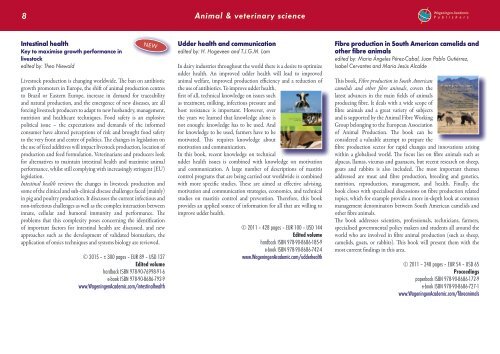Wageningen Academic Publishers - Catalogue 2015
Wageningen Academic Publishers - Catalogue 2015
Wageningen Academic Publishers - Catalogue 2015
You also want an ePaper? Increase the reach of your titles
YUMPU automatically turns print PDFs into web optimized ePapers that Google loves.
8 Animal & veterinary science<br />
<strong>Wageningen</strong> <strong>Academic</strong><br />
P u b l i s h e r s<br />
Intestinal health<br />
Key to maximise growth performance in<br />
livestock<br />
edited by: Theo Niewold<br />
NEW<br />
Livestock production is changing worldwide. The ban on antibiotic<br />
growth promoters in Europe, the shift of animal production centres<br />
to Brazil or Eastern Europe, increase in demand for traceability<br />
and natural production, and the emergence of new diseases, are all<br />
forcing livestock producers to adapt to new husbandry, management,<br />
nutrition and healthcare techniques. Food safety is an explosive<br />
political issue – the expectations and demands of the informed<br />
consumer have altered perceptions of risk and brought food safety<br />
to the very front and centre of politics. The changes in legislation on<br />
the use of feed additives will impact livestock production, location of<br />
production and feed formulation. Veterinarians and producers look<br />
for alternatives to maintain intestinal health and maximise animal<br />
performance, whilst still complying with increasingly stringent (EU)<br />
legislation.<br />
Intestinal health reviews the changes in livestock production and<br />
some of the clinical and sub-clinical disease challenges faced (mainly)<br />
in pig and poultry production. It discusses the current infectious and<br />
non-infectious challenges as well as the complex interaction between<br />
innate, cellular and humoral immunity and performance. The<br />
problems that this complexity poses concerning the identification<br />
of important factors for intestinal health are discussed, and new<br />
approaches such as the development of validated biomarkers, the<br />
application of omics techniques and systems biology are reviewed.<br />
© <strong>2015</strong> – ± 300 pages – EUR 89 – USD 127<br />
Edited volume<br />
hardback ISBN 978-90-76998-91-6<br />
e-book ISBN 978-90-8686-792-9<br />
www.<strong>Wageningen</strong><strong>Academic</strong>.com/intestinalhealth<br />
Udder health and communication<br />
edited by: H. Hogeveen and T.J.G.M. Lam<br />
In dairy industries throughout the world there is a desire to optimize<br />
udder health. An improved udder health will lead to improved<br />
animal welfare, improved production efficiency and a reduction of<br />
the use of antibiotics. To improve udder health,<br />
first of all, technical knowledge on issues such<br />
as treatment, milking, infectious pressure and<br />
host resistance is important. However, over<br />
the years we learned that knowledge alone is<br />
not enough: knowledge has to be used. And<br />
for knowledge to be used, farmers have to be<br />
motivated. This requires knowledge about<br />
motivation and communication.<br />
In this book, recent knowledge on technical<br />
udder health issues is combined with knowledge on motivation<br />
and communication. A large number of descriptions of mastitis<br />
control programs that are being carried out worldwide is combined<br />
with more specific studies. These are aimed at effective advising,<br />
motivation and communication strategies, economics, and technical<br />
studies on mastitis control and prevention. Therefore, this book<br />
provides an applied source of information for all that are willing to<br />
improve udder health.<br />
© 2011 – 428 pages – EUR 100 – USD 144<br />
Edited volume<br />
hardback ISBN 978-90-8686-185-9<br />
e-book ISBN 978-90-8686-742-4<br />
www.<strong>Wageningen</strong><strong>Academic</strong>.com/udderhealth<br />
Fibre production in South American camelids and<br />
other fibre animals<br />
edited by: Maria Ángeles Pérez-Cabal, Juan Pablo Gutiérrez,<br />
Isabel Cervantes and Maria Jesús Alcalde<br />
This book, Fibre production in South American<br />
camelids and other fibre animals, covers the<br />
latest advances in the main fields of animals<br />
producing fibre. It deals with a wide scope of<br />
fibre animals and a great variety of subjects<br />
and is supported by the Animal Fibre Working<br />
Group belonging to the European Association<br />
of Animal Production. The book can be<br />
considered a valuable attempt to prepare the<br />
fibre production sector for rapid changes and innovations arising<br />
within a globalised world. The focus lies on fibre animals such as<br />
alpacas, llamas, vicunas and guanacos, but recent research on sheep,<br />
goats and rabbits is also included. The most important themes<br />
addressed are meat and fibre production, breeding and genetics,<br />
nutrition, reproduction, management, and health. Finally, the<br />
book closes with specialised discussions on fibre production related<br />
topics, which for example provide a more in-depth look at common<br />
management denominators between South American camelids and<br />
other fibre animals.<br />
The book addresses scientists, professionals, technicians, farmers,<br />
specialised governmental policy makers and students all around the<br />
world who are involved in fibre animal production (such as sheep,<br />
camelids, goats, or rabbits). This book will present them with the<br />
most current findings in this area.<br />
© 2011 – 248 pages – EUR 54 – USD 65<br />
Proceedings<br />
paperback ISBN 978-90-8686-172-9<br />
e-book ISBN 978-90-8686-727-1<br />
www.<strong>Wageningen</strong><strong>Academic</strong>.com/fibreanimals


